Literature Review: The Role of FDI in Nepal's Economic Development
VerifiedAdded on 2022/12/15
|29
|9935
|151
Literature Review
AI Summary
This literature review explores the significant role of Foreign Direct Investment (FDI) in the development of Nepal. It examines the concept of FDI, its implications, and benefits to the country, particularly focusing on Nepal's context as an underdeveloped nation. The research highlights the importance of acknowledging a country's strengths for effective FDI application in sectors like agriculture, transportation, communication, and industry. It further delves into Nepal's economic progress through five-year plans, privatization, and foreign aid contributions, emphasizing the impact on tourism, the economy, and the living standards of the people. The review identifies gaps in the existing literature and suggests areas for future research, aiming to enhance the understanding of FDI's role in Nepal's sustainable development. Desklib offers access to similar solved assignments and resources for students.
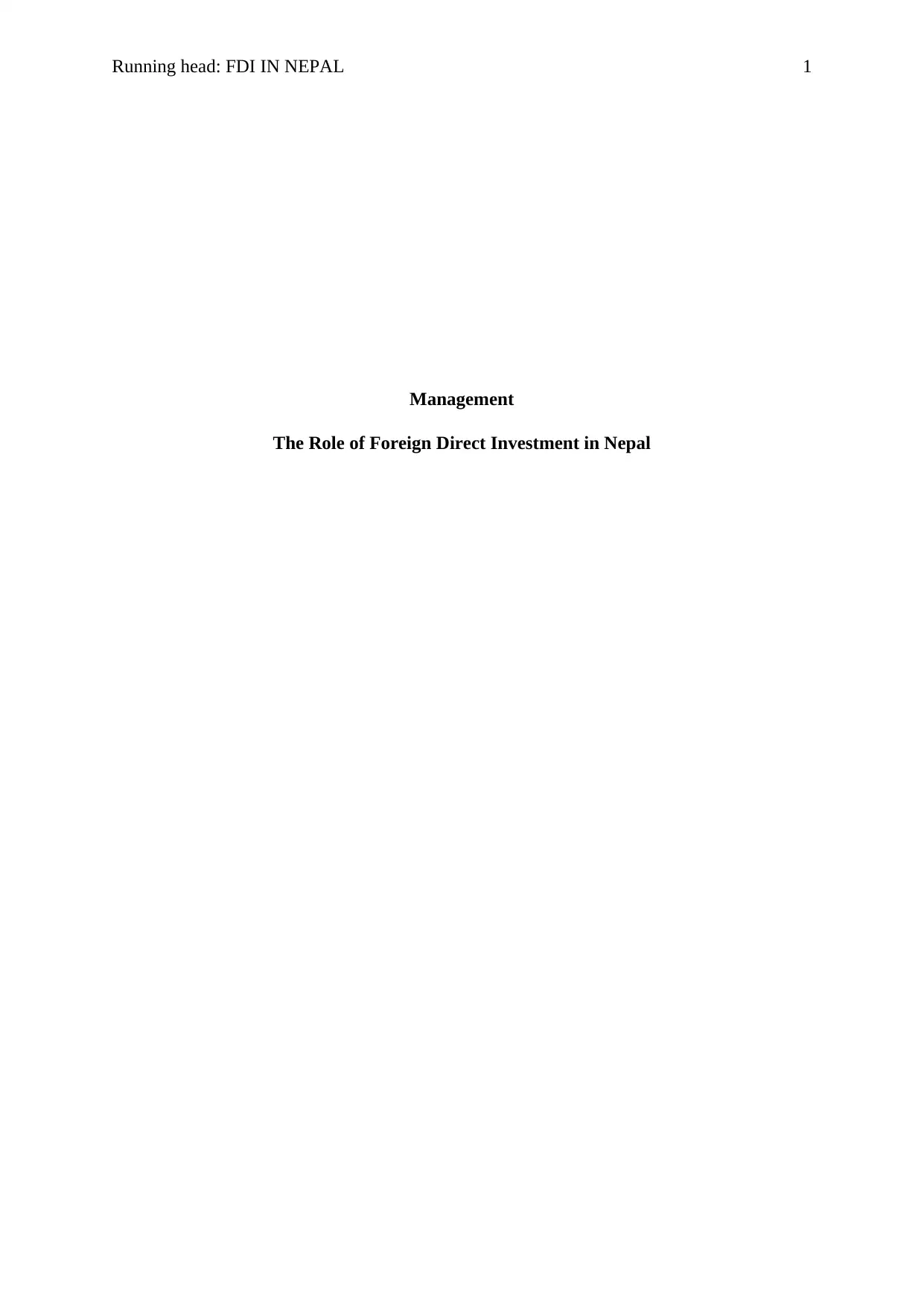
Running head: FDI IN NEPAL 1
Management
The Role of Foreign Direct Investment in Nepal
Management
The Role of Foreign Direct Investment in Nepal
Paraphrase This Document
Need a fresh take? Get an instant paraphrase of this document with our AI Paraphraser
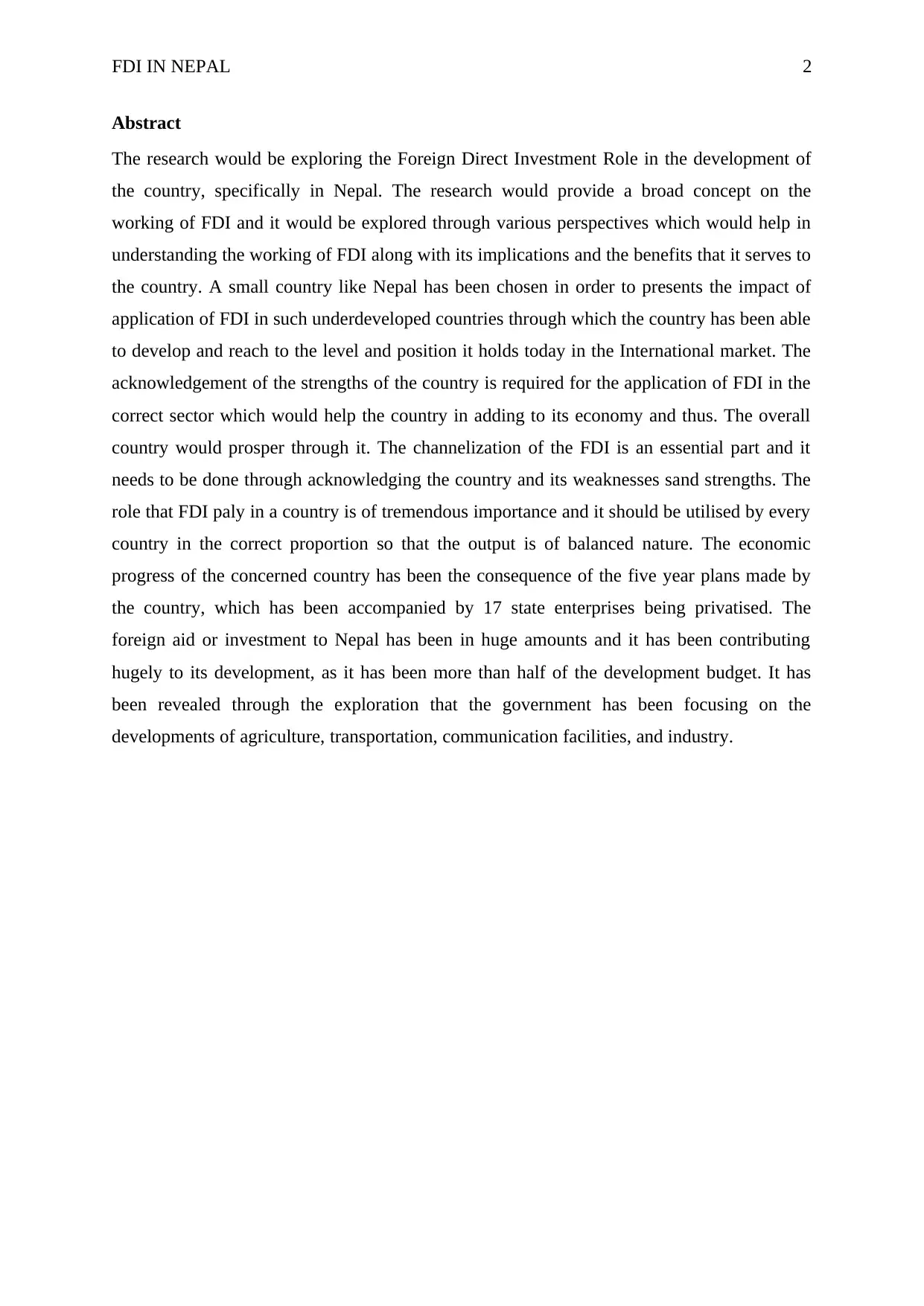
FDI IN NEPAL 2
Abstract
The research would be exploring the Foreign Direct Investment Role in the development of
the country, specifically in Nepal. The research would provide a broad concept on the
working of FDI and it would be explored through various perspectives which would help in
understanding the working of FDI along with its implications and the benefits that it serves to
the country. A small country like Nepal has been chosen in order to presents the impact of
application of FDI in such underdeveloped countries through which the country has been able
to develop and reach to the level and position it holds today in the International market. The
acknowledgement of the strengths of the country is required for the application of FDI in the
correct sector which would help the country in adding to its economy and thus. The overall
country would prosper through it. The channelization of the FDI is an essential part and it
needs to be done through acknowledging the country and its weaknesses sand strengths. The
role that FDI paly in a country is of tremendous importance and it should be utilised by every
country in the correct proportion so that the output is of balanced nature. The economic
progress of the concerned country has been the consequence of the five year plans made by
the country, which has been accompanied by 17 state enterprises being privatised. The
foreign aid or investment to Nepal has been in huge amounts and it has been contributing
hugely to its development, as it has been more than half of the development budget. It has
been revealed through the exploration that the government has been focusing on the
developments of agriculture, transportation, communication facilities, and industry.
Abstract
The research would be exploring the Foreign Direct Investment Role in the development of
the country, specifically in Nepal. The research would provide a broad concept on the
working of FDI and it would be explored through various perspectives which would help in
understanding the working of FDI along with its implications and the benefits that it serves to
the country. A small country like Nepal has been chosen in order to presents the impact of
application of FDI in such underdeveloped countries through which the country has been able
to develop and reach to the level and position it holds today in the International market. The
acknowledgement of the strengths of the country is required for the application of FDI in the
correct sector which would help the country in adding to its economy and thus. The overall
country would prosper through it. The channelization of the FDI is an essential part and it
needs to be done through acknowledging the country and its weaknesses sand strengths. The
role that FDI paly in a country is of tremendous importance and it should be utilised by every
country in the correct proportion so that the output is of balanced nature. The economic
progress of the concerned country has been the consequence of the five year plans made by
the country, which has been accompanied by 17 state enterprises being privatised. The
foreign aid or investment to Nepal has been in huge amounts and it has been contributing
hugely to its development, as it has been more than half of the development budget. It has
been revealed through the exploration that the government has been focusing on the
developments of agriculture, transportation, communication facilities, and industry.
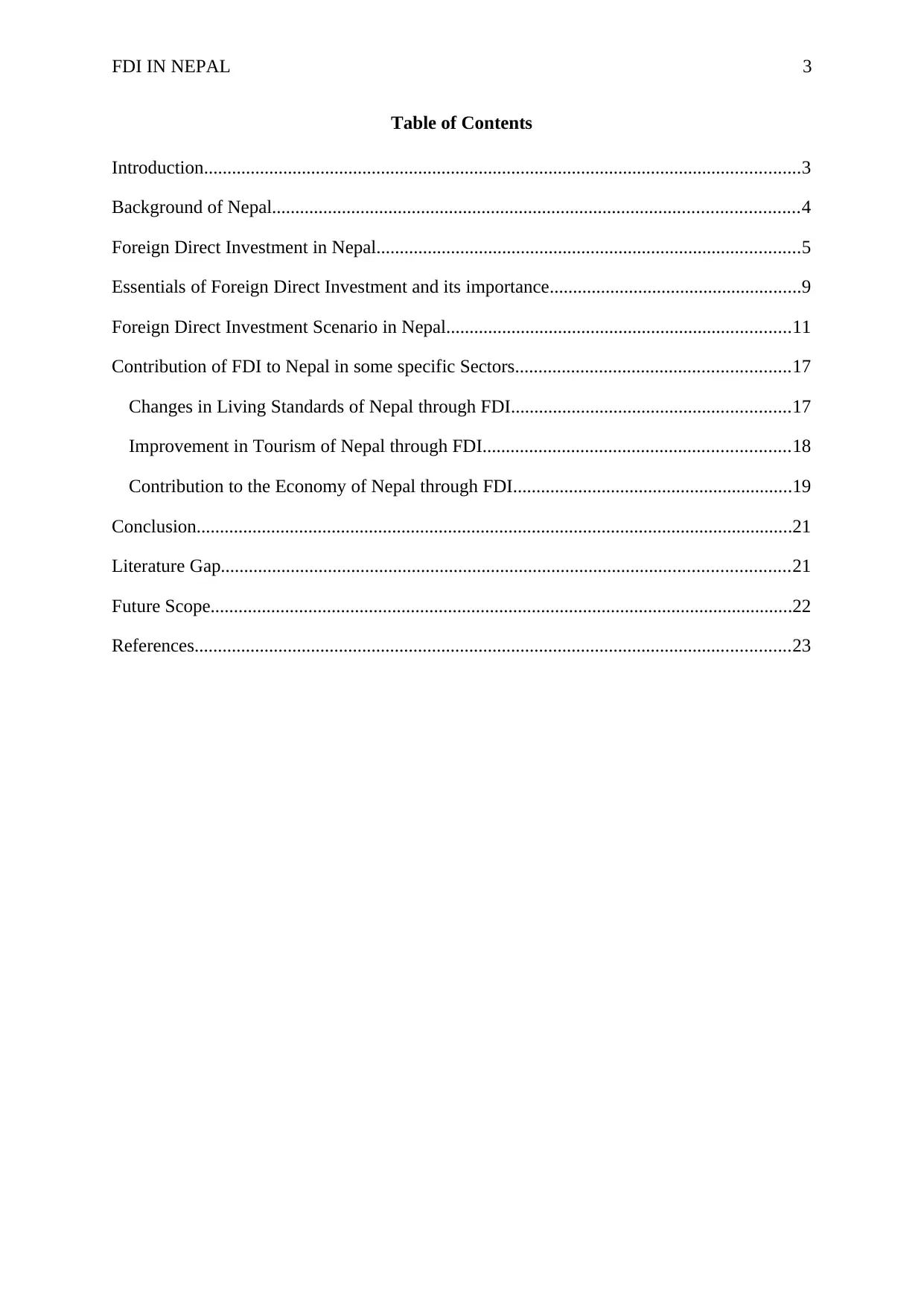
FDI IN NEPAL 3
Table of Contents
Introduction................................................................................................................................3
Background of Nepal.................................................................................................................4
Foreign Direct Investment in Nepal...........................................................................................5
Essentials of Foreign Direct Investment and its importance......................................................9
Foreign Direct Investment Scenario in Nepal..........................................................................11
Contribution of FDI to Nepal in some specific Sectors...........................................................17
Changes in Living Standards of Nepal through FDI............................................................17
Improvement in Tourism of Nepal through FDI..................................................................18
Contribution to the Economy of Nepal through FDI............................................................19
Conclusion................................................................................................................................21
Literature Gap..........................................................................................................................21
Future Scope.............................................................................................................................22
References................................................................................................................................23
Table of Contents
Introduction................................................................................................................................3
Background of Nepal.................................................................................................................4
Foreign Direct Investment in Nepal...........................................................................................5
Essentials of Foreign Direct Investment and its importance......................................................9
Foreign Direct Investment Scenario in Nepal..........................................................................11
Contribution of FDI to Nepal in some specific Sectors...........................................................17
Changes in Living Standards of Nepal through FDI............................................................17
Improvement in Tourism of Nepal through FDI..................................................................18
Contribution to the Economy of Nepal through FDI............................................................19
Conclusion................................................................................................................................21
Literature Gap..........................................................................................................................21
Future Scope.............................................................................................................................22
References................................................................................................................................23
⊘ This is a preview!⊘
Do you want full access?
Subscribe today to unlock all pages.

Trusted by 1+ million students worldwide
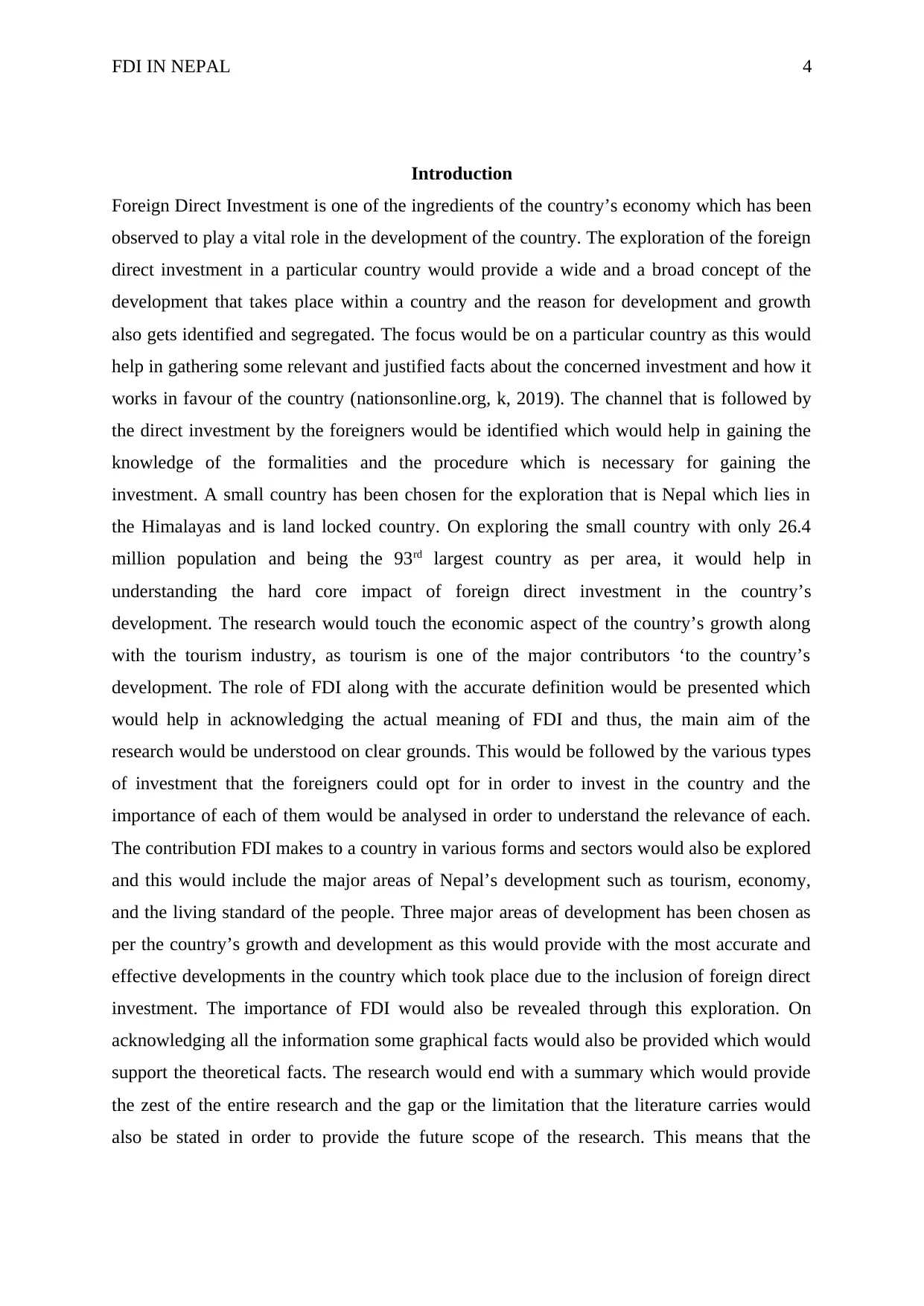
FDI IN NEPAL 4
Introduction
Foreign Direct Investment is one of the ingredients of the country’s economy which has been
observed to play a vital role in the development of the country. The exploration of the foreign
direct investment in a particular country would provide a wide and a broad concept of the
development that takes place within a country and the reason for development and growth
also gets identified and segregated. The focus would be on a particular country as this would
help in gathering some relevant and justified facts about the concerned investment and how it
works in favour of the country (nationsonline.org, k, 2019). The channel that is followed by
the direct investment by the foreigners would be identified which would help in gaining the
knowledge of the formalities and the procedure which is necessary for gaining the
investment. A small country has been chosen for the exploration that is Nepal which lies in
the Himalayas and is land locked country. On exploring the small country with only 26.4
million population and being the 93rd largest country as per area, it would help in
understanding the hard core impact of foreign direct investment in the country’s
development. The research would touch the economic aspect of the country’s growth along
with the tourism industry, as tourism is one of the major contributors ‘to the country’s
development. The role of FDI along with the accurate definition would be presented which
would help in acknowledging the actual meaning of FDI and thus, the main aim of the
research would be understood on clear grounds. This would be followed by the various types
of investment that the foreigners could opt for in order to invest in the country and the
importance of each of them would be analysed in order to understand the relevance of each.
The contribution FDI makes to a country in various forms and sectors would also be explored
and this would include the major areas of Nepal’s development such as tourism, economy,
and the living standard of the people. Three major areas of development has been chosen as
per the country’s growth and development as this would provide with the most accurate and
effective developments in the country which took place due to the inclusion of foreign direct
investment. The importance of FDI would also be revealed through this exploration. On
acknowledging all the information some graphical facts would also be provided which would
support the theoretical facts. The research would end with a summary which would provide
the zest of the entire research and the gap or the limitation that the literature carries would
also be stated in order to provide the future scope of the research. This means that the
Introduction
Foreign Direct Investment is one of the ingredients of the country’s economy which has been
observed to play a vital role in the development of the country. The exploration of the foreign
direct investment in a particular country would provide a wide and a broad concept of the
development that takes place within a country and the reason for development and growth
also gets identified and segregated. The focus would be on a particular country as this would
help in gathering some relevant and justified facts about the concerned investment and how it
works in favour of the country (nationsonline.org, k, 2019). The channel that is followed by
the direct investment by the foreigners would be identified which would help in gaining the
knowledge of the formalities and the procedure which is necessary for gaining the
investment. A small country has been chosen for the exploration that is Nepal which lies in
the Himalayas and is land locked country. On exploring the small country with only 26.4
million population and being the 93rd largest country as per area, it would help in
understanding the hard core impact of foreign direct investment in the country’s
development. The research would touch the economic aspect of the country’s growth along
with the tourism industry, as tourism is one of the major contributors ‘to the country’s
development. The role of FDI along with the accurate definition would be presented which
would help in acknowledging the actual meaning of FDI and thus, the main aim of the
research would be understood on clear grounds. This would be followed by the various types
of investment that the foreigners could opt for in order to invest in the country and the
importance of each of them would be analysed in order to understand the relevance of each.
The contribution FDI makes to a country in various forms and sectors would also be explored
and this would include the major areas of Nepal’s development such as tourism, economy,
and the living standard of the people. Three major areas of development has been chosen as
per the country’s growth and development as this would provide with the most accurate and
effective developments in the country which took place due to the inclusion of foreign direct
investment. The importance of FDI would also be revealed through this exploration. On
acknowledging all the information some graphical facts would also be provided which would
support the theoretical facts. The research would end with a summary which would provide
the zest of the entire research and the gap or the limitation that the literature carries would
also be stated in order to provide the future scope of the research. This means that the
Paraphrase This Document
Need a fresh take? Get an instant paraphrase of this document with our AI Paraphraser
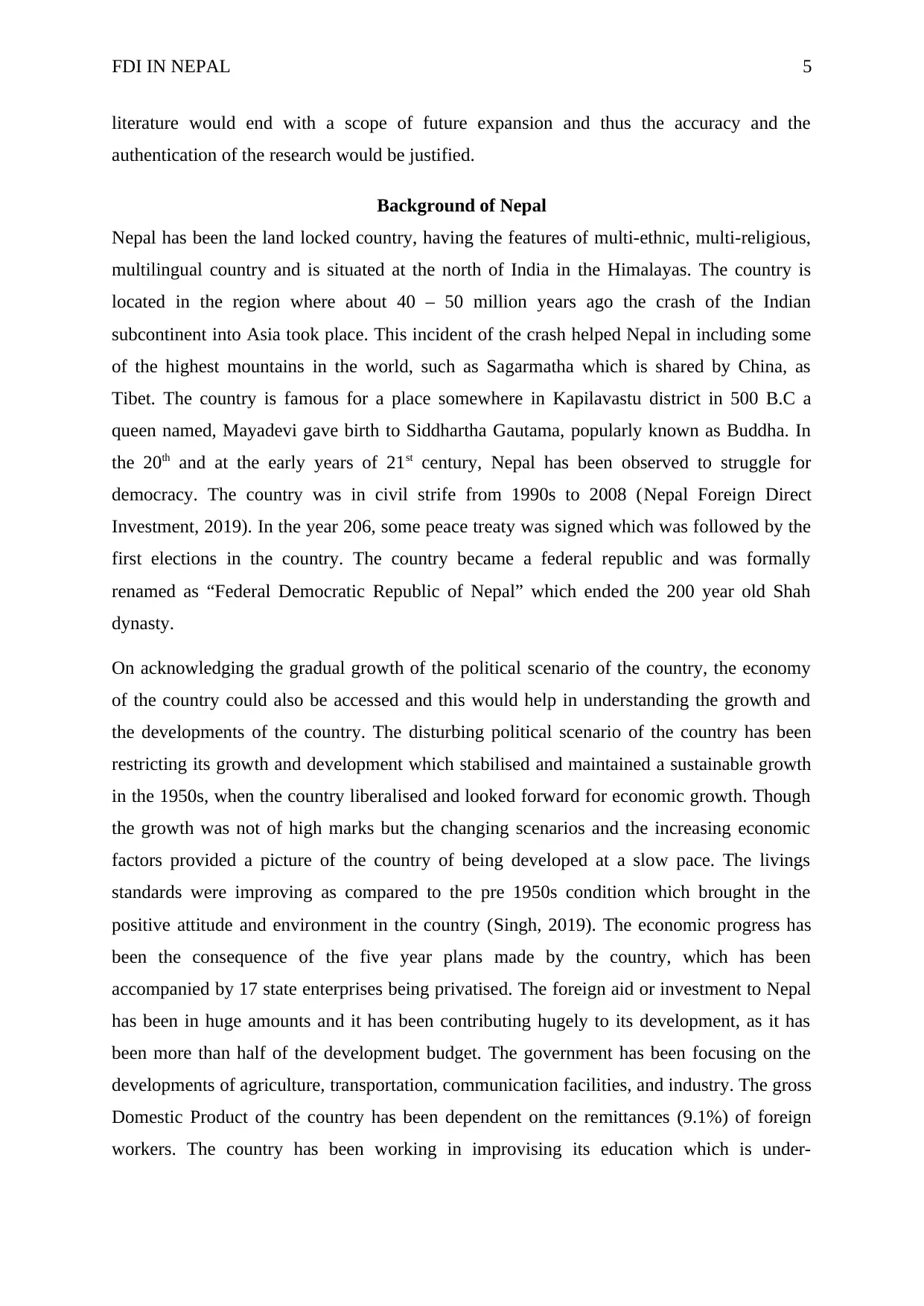
FDI IN NEPAL 5
literature would end with a scope of future expansion and thus the accuracy and the
authentication of the research would be justified.
Background of Nepal
Nepal has been the land locked country, having the features of multi-ethnic, multi-religious,
multilingual country and is situated at the north of India in the Himalayas. The country is
located in the region where about 40 – 50 million years ago the crash of the Indian
subcontinent into Asia took place. This incident of the crash helped Nepal in including some
of the highest mountains in the world, such as Sagarmatha which is shared by China, as
Tibet. The country is famous for a place somewhere in Kapilavastu district in 500 B.C a
queen named, Mayadevi gave birth to Siddhartha Gautama, popularly known as Buddha. In
the 20th and at the early years of 21st century, Nepal has been observed to struggle for
democracy. The country was in civil strife from 1990s to 2008 (Nepal Foreign Direct
Investment, 2019). In the year 206, some peace treaty was signed which was followed by the
first elections in the country. The country became a federal republic and was formally
renamed as “Federal Democratic Republic of Nepal” which ended the 200 year old Shah
dynasty.
On acknowledging the gradual growth of the political scenario of the country, the economy
of the country could also be accessed and this would help in understanding the growth and
the developments of the country. The disturbing political scenario of the country has been
restricting its growth and development which stabilised and maintained a sustainable growth
in the 1950s, when the country liberalised and looked forward for economic growth. Though
the growth was not of high marks but the changing scenarios and the increasing economic
factors provided a picture of the country of being developed at a slow pace. The livings
standards were improving as compared to the pre 1950s condition which brought in the
positive attitude and environment in the country (Singh, 2019). The economic progress has
been the consequence of the five year plans made by the country, which has been
accompanied by 17 state enterprises being privatised. The foreign aid or investment to Nepal
has been in huge amounts and it has been contributing hugely to its development, as it has
been more than half of the development budget. The government has been focusing on the
developments of agriculture, transportation, communication facilities, and industry. The gross
Domestic Product of the country has been dependent on the remittances (9.1%) of foreign
workers. The country has been working in improvising its education which is under-
literature would end with a scope of future expansion and thus the accuracy and the
authentication of the research would be justified.
Background of Nepal
Nepal has been the land locked country, having the features of multi-ethnic, multi-religious,
multilingual country and is situated at the north of India in the Himalayas. The country is
located in the region where about 40 – 50 million years ago the crash of the Indian
subcontinent into Asia took place. This incident of the crash helped Nepal in including some
of the highest mountains in the world, such as Sagarmatha which is shared by China, as
Tibet. The country is famous for a place somewhere in Kapilavastu district in 500 B.C a
queen named, Mayadevi gave birth to Siddhartha Gautama, popularly known as Buddha. In
the 20th and at the early years of 21st century, Nepal has been observed to struggle for
democracy. The country was in civil strife from 1990s to 2008 (Nepal Foreign Direct
Investment, 2019). In the year 206, some peace treaty was signed which was followed by the
first elections in the country. The country became a federal republic and was formally
renamed as “Federal Democratic Republic of Nepal” which ended the 200 year old Shah
dynasty.
On acknowledging the gradual growth of the political scenario of the country, the economy
of the country could also be accessed and this would help in understanding the growth and
the developments of the country. The disturbing political scenario of the country has been
restricting its growth and development which stabilised and maintained a sustainable growth
in the 1950s, when the country liberalised and looked forward for economic growth. Though
the growth was not of high marks but the changing scenarios and the increasing economic
factors provided a picture of the country of being developed at a slow pace. The livings
standards were improving as compared to the pre 1950s condition which brought in the
positive attitude and environment in the country (Singh, 2019). The economic progress has
been the consequence of the five year plans made by the country, which has been
accompanied by 17 state enterprises being privatised. The foreign aid or investment to Nepal
has been in huge amounts and it has been contributing hugely to its development, as it has
been more than half of the development budget. The government has been focusing on the
developments of agriculture, transportation, communication facilities, and industry. The gross
Domestic Product of the country has been dependent on the remittances (9.1%) of foreign
workers. The country has been working in improvising its education which is under-
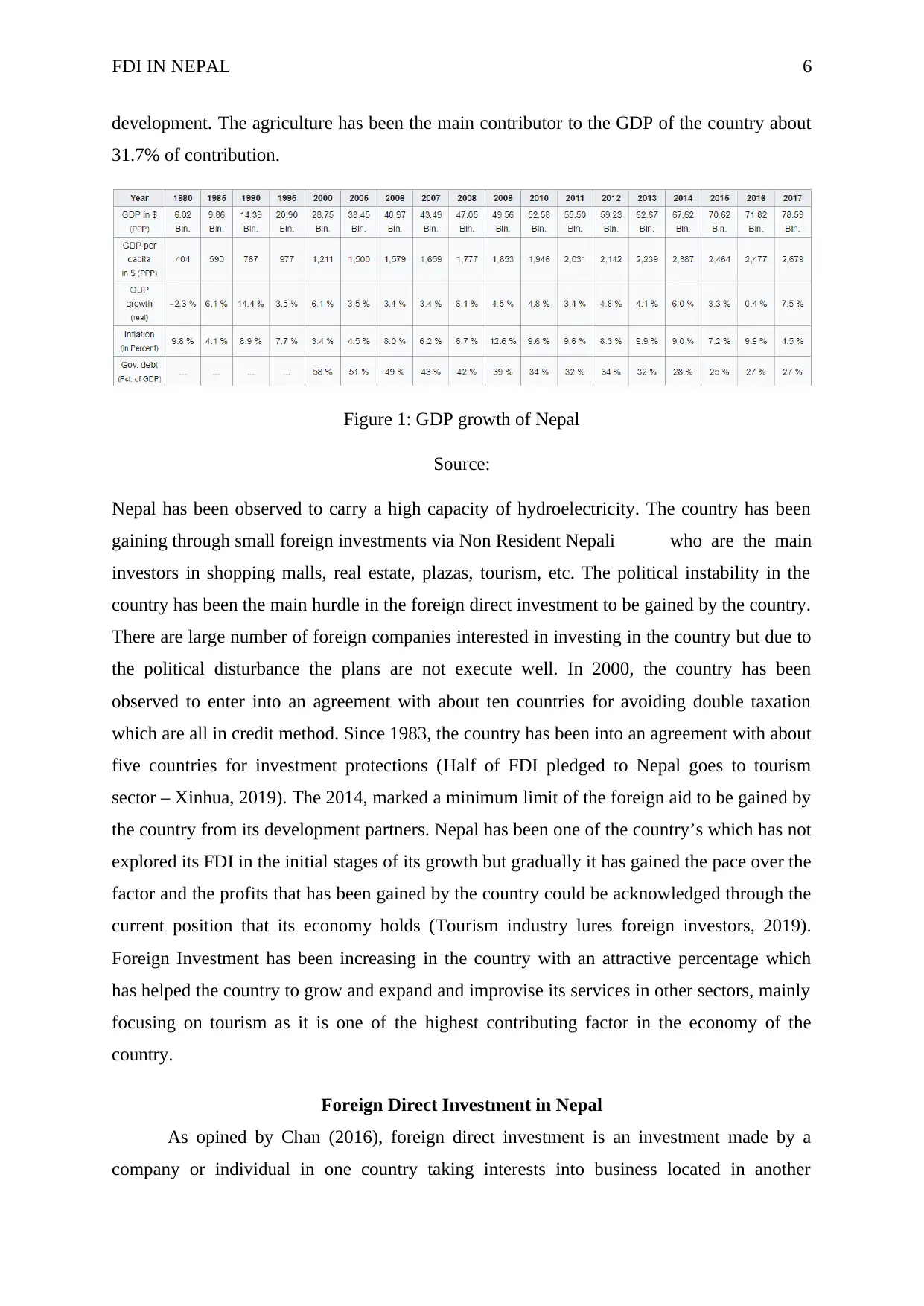
FDI IN NEPAL 6
development. The agriculture has been the main contributor to the GDP of the country about
31.7% of contribution.
Figure 1: GDP growth of Nepal
Source:
Nepal has been observed to carry a high capacity of hydroelectricity. The country has been
gaining through small foreign investments via Non Resident Nepali who are the main
investors in shopping malls, real estate, plazas, tourism, etc. The political instability in the
country has been the main hurdle in the foreign direct investment to be gained by the country.
There are large number of foreign companies interested in investing in the country but due to
the political disturbance the plans are not execute well. In 2000, the country has been
observed to enter into an agreement with about ten countries for avoiding double taxation
which are all in credit method. Since 1983, the country has been into an agreement with about
five countries for investment protections (Half of FDI pledged to Nepal goes to tourism
sector – Xinhua, 2019). The 2014, marked a minimum limit of the foreign aid to be gained by
the country from its development partners. Nepal has been one of the country’s which has not
explored its FDI in the initial stages of its growth but gradually it has gained the pace over the
factor and the profits that has been gained by the country could be acknowledged through the
current position that its economy holds (Tourism industry lures foreign investors, 2019).
Foreign Investment has been increasing in the country with an attractive percentage which
has helped the country to grow and expand and improvise its services in other sectors, mainly
focusing on tourism as it is one of the highest contributing factor in the economy of the
country.
Foreign Direct Investment in Nepal
As opined by Chan (2016), foreign direct investment is an investment made by a
company or individual in one country taking interests into business located in another
development. The agriculture has been the main contributor to the GDP of the country about
31.7% of contribution.
Figure 1: GDP growth of Nepal
Source:
Nepal has been observed to carry a high capacity of hydroelectricity. The country has been
gaining through small foreign investments via Non Resident Nepali who are the main
investors in shopping malls, real estate, plazas, tourism, etc. The political instability in the
country has been the main hurdle in the foreign direct investment to be gained by the country.
There are large number of foreign companies interested in investing in the country but due to
the political disturbance the plans are not execute well. In 2000, the country has been
observed to enter into an agreement with about ten countries for avoiding double taxation
which are all in credit method. Since 1983, the country has been into an agreement with about
five countries for investment protections (Half of FDI pledged to Nepal goes to tourism
sector – Xinhua, 2019). The 2014, marked a minimum limit of the foreign aid to be gained by
the country from its development partners. Nepal has been one of the country’s which has not
explored its FDI in the initial stages of its growth but gradually it has gained the pace over the
factor and the profits that has been gained by the country could be acknowledged through the
current position that its economy holds (Tourism industry lures foreign investors, 2019).
Foreign Investment has been increasing in the country with an attractive percentage which
has helped the country to grow and expand and improvise its services in other sectors, mainly
focusing on tourism as it is one of the highest contributing factor in the economy of the
country.
Foreign Direct Investment in Nepal
As opined by Chan (2016), foreign direct investment is an investment made by a
company or individual in one country taking interests into business located in another
⊘ This is a preview!⊘
Do you want full access?
Subscribe today to unlock all pages.

Trusted by 1+ million students worldwide
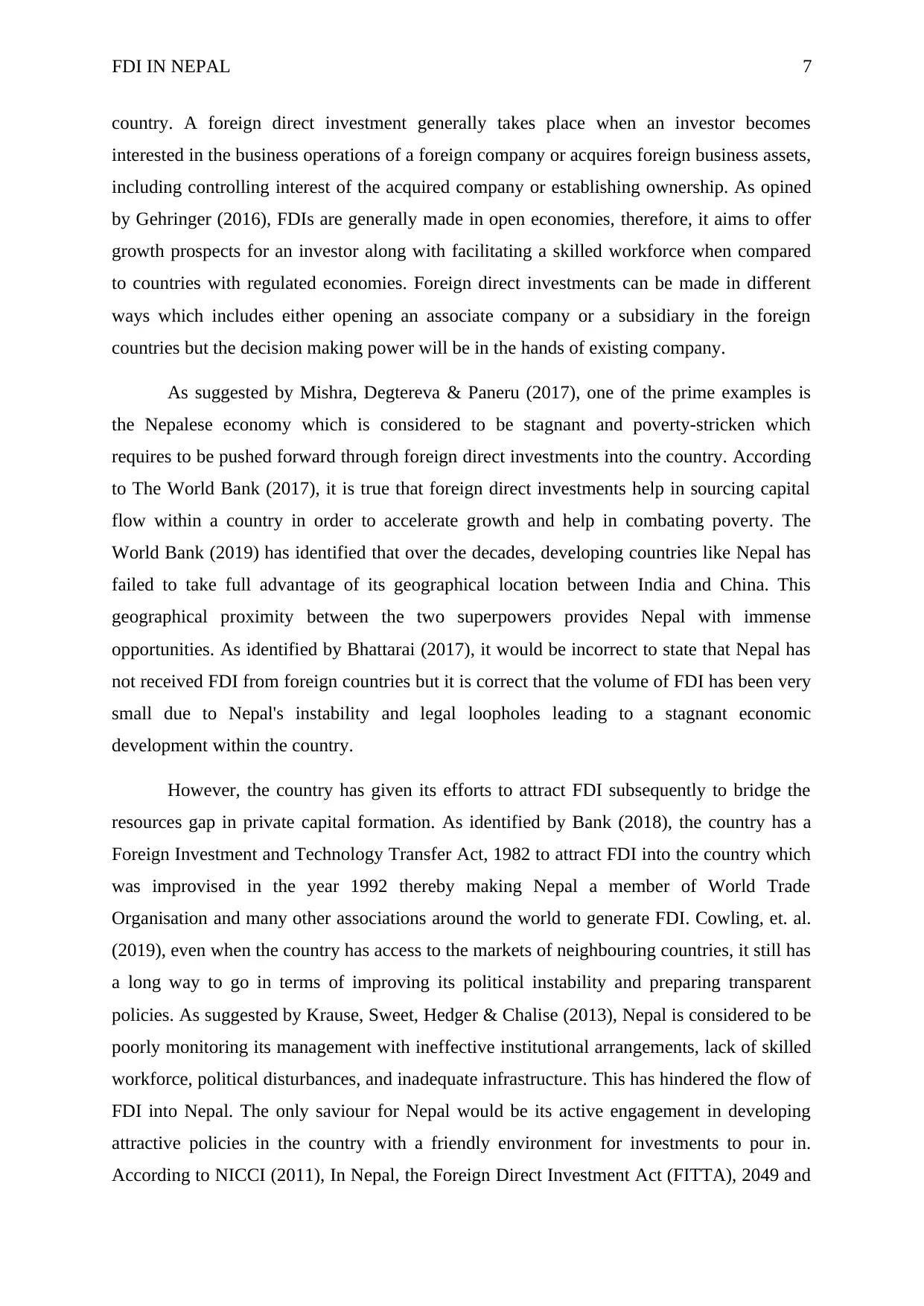
FDI IN NEPAL 7
country. A foreign direct investment generally takes place when an investor becomes
interested in the business operations of a foreign company or acquires foreign business assets,
including controlling interest of the acquired company or establishing ownership. As opined
by Gehringer (2016), FDIs are generally made in open economies, therefore, it aims to offer
growth prospects for an investor along with facilitating a skilled workforce when compared
to countries with regulated economies. Foreign direct investments can be made in different
ways which includes either opening an associate company or a subsidiary in the foreign
countries but the decision making power will be in the hands of existing company.
As suggested by Mishra, Degtereva & Paneru (2017), one of the prime examples is
the Nepalese economy which is considered to be stagnant and poverty-stricken which
requires to be pushed forward through foreign direct investments into the country. According
to The World Bank (2017), it is true that foreign direct investments help in sourcing capital
flow within a country in order to accelerate growth and help in combating poverty. The
World Bank (2019) has identified that over the decades, developing countries like Nepal has
failed to take full advantage of its geographical location between India and China. This
geographical proximity between the two superpowers provides Nepal with immense
opportunities. As identified by Bhattarai (2017), it would be incorrect to state that Nepal has
not received FDI from foreign countries but it is correct that the volume of FDI has been very
small due to Nepal's instability and legal loopholes leading to a stagnant economic
development within the country.
However, the country has given its efforts to attract FDI subsequently to bridge the
resources gap in private capital formation. As identified by Bank (2018), the country has a
Foreign Investment and Technology Transfer Act, 1982 to attract FDI into the country which
was improvised in the year 1992 thereby making Nepal a member of World Trade
Organisation and many other associations around the world to generate FDI. Cowling, et. al.
(2019), even when the country has access to the markets of neighbouring countries, it still has
a long way to go in terms of improving its political instability and preparing transparent
policies. As suggested by Krause, Sweet, Hedger & Chalise (2013), Nepal is considered to be
poorly monitoring its management with ineffective institutional arrangements, lack of skilled
workforce, political disturbances, and inadequate infrastructure. This has hindered the flow of
FDI into Nepal. The only saviour for Nepal would be its active engagement in developing
attractive policies in the country with a friendly environment for investments to pour in.
According to NICCI (2011), In Nepal, the Foreign Direct Investment Act (FITTA), 2049 and
country. A foreign direct investment generally takes place when an investor becomes
interested in the business operations of a foreign company or acquires foreign business assets,
including controlling interest of the acquired company or establishing ownership. As opined
by Gehringer (2016), FDIs are generally made in open economies, therefore, it aims to offer
growth prospects for an investor along with facilitating a skilled workforce when compared
to countries with regulated economies. Foreign direct investments can be made in different
ways which includes either opening an associate company or a subsidiary in the foreign
countries but the decision making power will be in the hands of existing company.
As suggested by Mishra, Degtereva & Paneru (2017), one of the prime examples is
the Nepalese economy which is considered to be stagnant and poverty-stricken which
requires to be pushed forward through foreign direct investments into the country. According
to The World Bank (2017), it is true that foreign direct investments help in sourcing capital
flow within a country in order to accelerate growth and help in combating poverty. The
World Bank (2019) has identified that over the decades, developing countries like Nepal has
failed to take full advantage of its geographical location between India and China. This
geographical proximity between the two superpowers provides Nepal with immense
opportunities. As identified by Bhattarai (2017), it would be incorrect to state that Nepal has
not received FDI from foreign countries but it is correct that the volume of FDI has been very
small due to Nepal's instability and legal loopholes leading to a stagnant economic
development within the country.
However, the country has given its efforts to attract FDI subsequently to bridge the
resources gap in private capital formation. As identified by Bank (2018), the country has a
Foreign Investment and Technology Transfer Act, 1982 to attract FDI into the country which
was improvised in the year 1992 thereby making Nepal a member of World Trade
Organisation and many other associations around the world to generate FDI. Cowling, et. al.
(2019), even when the country has access to the markets of neighbouring countries, it still has
a long way to go in terms of improving its political instability and preparing transparent
policies. As suggested by Krause, Sweet, Hedger & Chalise (2013), Nepal is considered to be
poorly monitoring its management with ineffective institutional arrangements, lack of skilled
workforce, political disturbances, and inadequate infrastructure. This has hindered the flow of
FDI into Nepal. The only saviour for Nepal would be its active engagement in developing
attractive policies in the country with a friendly environment for investments to pour in.
According to NICCI (2011), In Nepal, the Foreign Direct Investment Act (FITTA), 2049 and
Paraphrase This Document
Need a fresh take? Get an instant paraphrase of this document with our AI Paraphraser
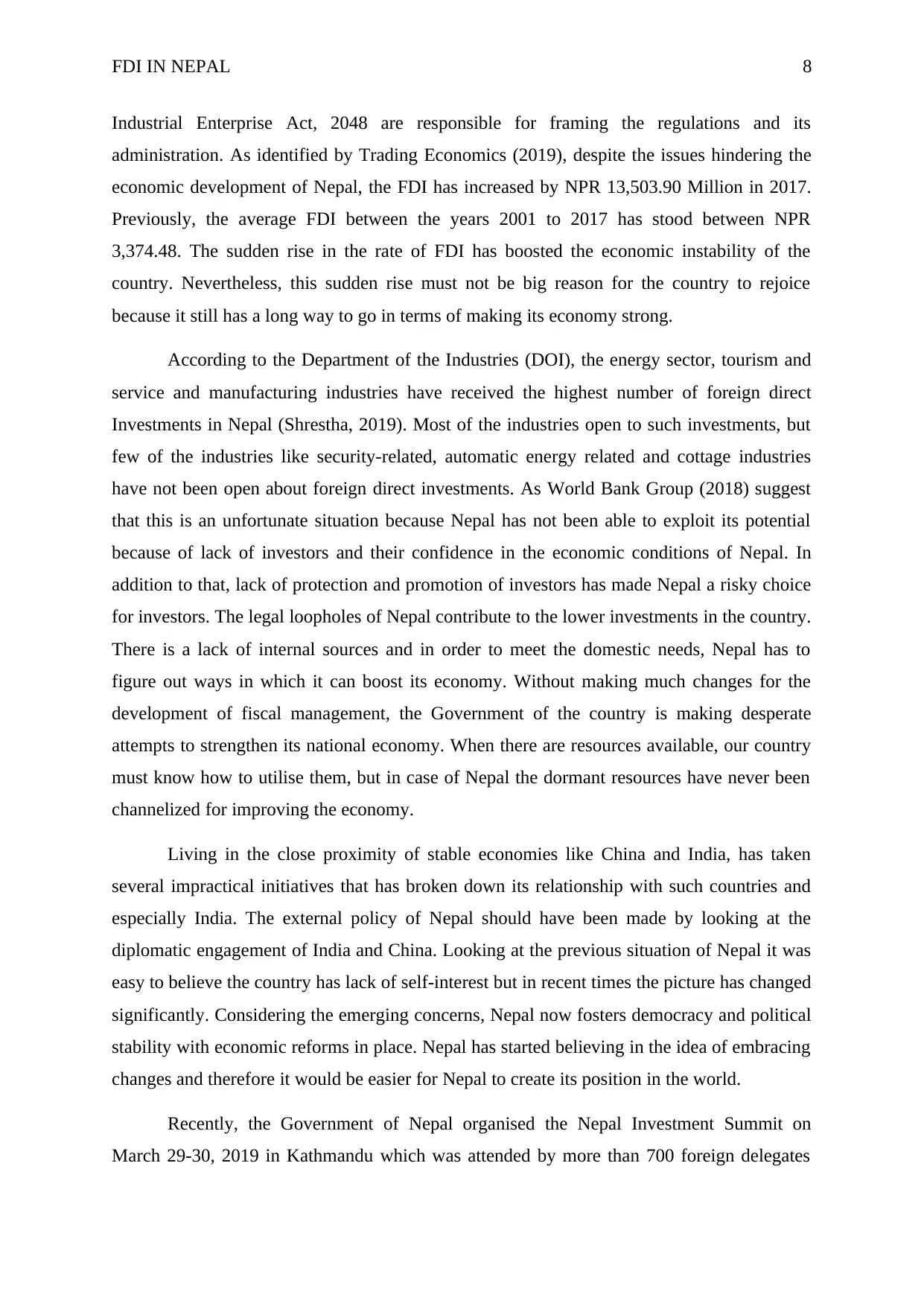
FDI IN NEPAL 8
Industrial Enterprise Act, 2048 are responsible for framing the regulations and its
administration. As identified by Trading Economics (2019), despite the issues hindering the
economic development of Nepal, the FDI has increased by NPR 13,503.90 Million in 2017.
Previously, the average FDI between the years 2001 to 2017 has stood between NPR
3,374.48. The sudden rise in the rate of FDI has boosted the economic instability of the
country. Nevertheless, this sudden rise must not be big reason for the country to rejoice
because it still has a long way to go in terms of making its economy strong.
According to the Department of the Industries (DOI), the energy sector, tourism and
service and manufacturing industries have received the highest number of foreign direct
Investments in Nepal (Shrestha, 2019). Most of the industries open to such investments, but
few of the industries like security-related, automatic energy related and cottage industries
have not been open about foreign direct investments. As World Bank Group (2018) suggest
that this is an unfortunate situation because Nepal has not been able to exploit its potential
because of lack of investors and their confidence in the economic conditions of Nepal. In
addition to that, lack of protection and promotion of investors has made Nepal a risky choice
for investors. The legal loopholes of Nepal contribute to the lower investments in the country.
There is a lack of internal sources and in order to meet the domestic needs, Nepal has to
figure out ways in which it can boost its economy. Without making much changes for the
development of fiscal management, the Government of the country is making desperate
attempts to strengthen its national economy. When there are resources available, our country
must know how to utilise them, but in case of Nepal the dormant resources have never been
channelized for improving the economy.
Living in the close proximity of stable economies like China and India, has taken
several impractical initiatives that has broken down its relationship with such countries and
especially India. The external policy of Nepal should have been made by looking at the
diplomatic engagement of India and China. Looking at the previous situation of Nepal it was
easy to believe the country has lack of self-interest but in recent times the picture has changed
significantly. Considering the emerging concerns, Nepal now fosters democracy and political
stability with economic reforms in place. Nepal has started believing in the idea of embracing
changes and therefore it would be easier for Nepal to create its position in the world.
Recently, the Government of Nepal organised the Nepal Investment Summit on
March 29-30, 2019 in Kathmandu which was attended by more than 700 foreign delegates
Industrial Enterprise Act, 2048 are responsible for framing the regulations and its
administration. As identified by Trading Economics (2019), despite the issues hindering the
economic development of Nepal, the FDI has increased by NPR 13,503.90 Million in 2017.
Previously, the average FDI between the years 2001 to 2017 has stood between NPR
3,374.48. The sudden rise in the rate of FDI has boosted the economic instability of the
country. Nevertheless, this sudden rise must not be big reason for the country to rejoice
because it still has a long way to go in terms of making its economy strong.
According to the Department of the Industries (DOI), the energy sector, tourism and
service and manufacturing industries have received the highest number of foreign direct
Investments in Nepal (Shrestha, 2019). Most of the industries open to such investments, but
few of the industries like security-related, automatic energy related and cottage industries
have not been open about foreign direct investments. As World Bank Group (2018) suggest
that this is an unfortunate situation because Nepal has not been able to exploit its potential
because of lack of investors and their confidence in the economic conditions of Nepal. In
addition to that, lack of protection and promotion of investors has made Nepal a risky choice
for investors. The legal loopholes of Nepal contribute to the lower investments in the country.
There is a lack of internal sources and in order to meet the domestic needs, Nepal has to
figure out ways in which it can boost its economy. Without making much changes for the
development of fiscal management, the Government of the country is making desperate
attempts to strengthen its national economy. When there are resources available, our country
must know how to utilise them, but in case of Nepal the dormant resources have never been
channelized for improving the economy.
Living in the close proximity of stable economies like China and India, has taken
several impractical initiatives that has broken down its relationship with such countries and
especially India. The external policy of Nepal should have been made by looking at the
diplomatic engagement of India and China. Looking at the previous situation of Nepal it was
easy to believe the country has lack of self-interest but in recent times the picture has changed
significantly. Considering the emerging concerns, Nepal now fosters democracy and political
stability with economic reforms in place. Nepal has started believing in the idea of embracing
changes and therefore it would be easier for Nepal to create its position in the world.
Recently, the Government of Nepal organised the Nepal Investment Summit on
March 29-30, 2019 in Kathmandu which was attended by more than 700 foreign delegates
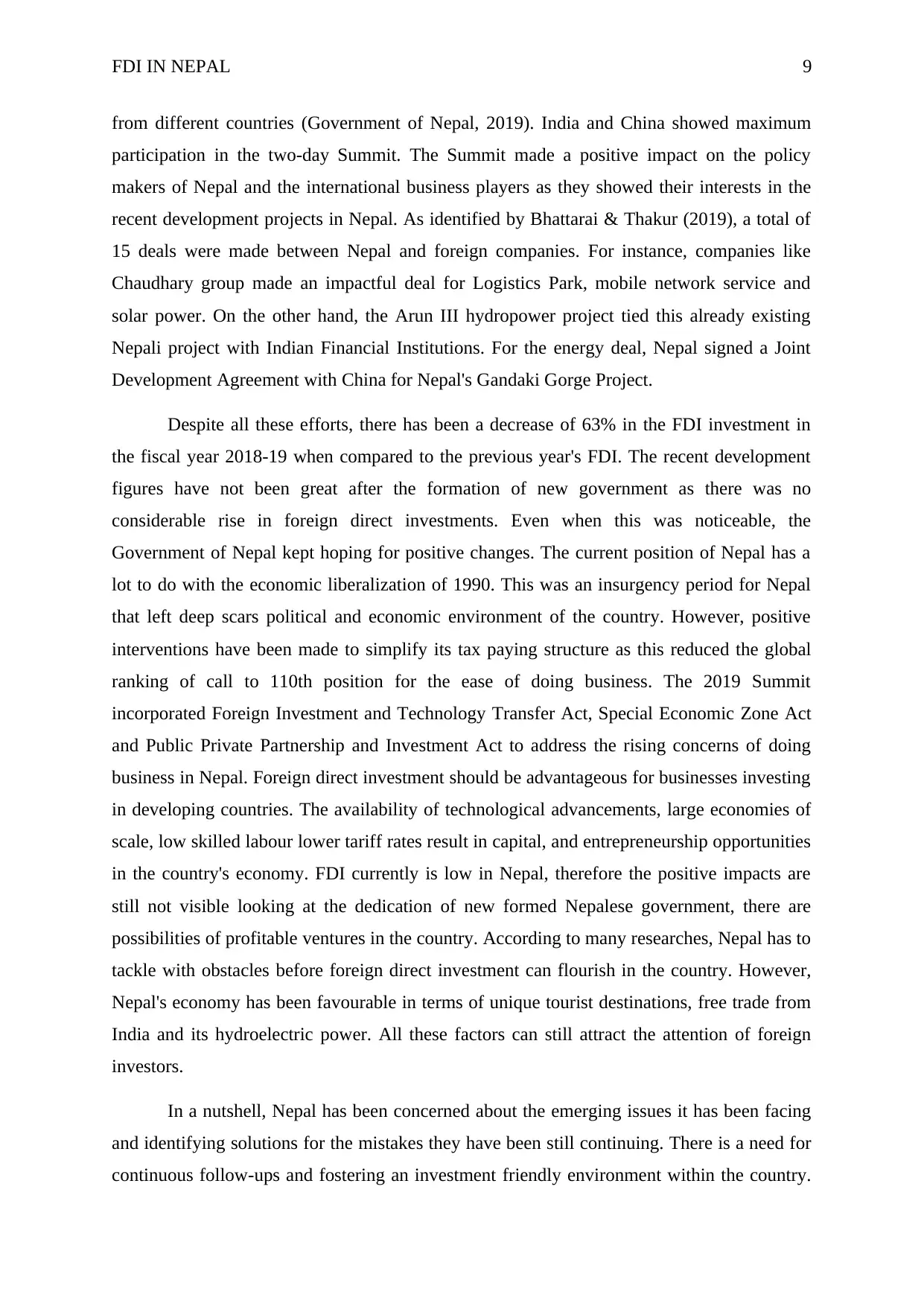
FDI IN NEPAL 9
from different countries (Government of Nepal, 2019). India and China showed maximum
participation in the two-day Summit. The Summit made a positive impact on the policy
makers of Nepal and the international business players as they showed their interests in the
recent development projects in Nepal. As identified by Bhattarai & Thakur (2019), a total of
15 deals were made between Nepal and foreign companies. For instance, companies like
Chaudhary group made an impactful deal for Logistics Park, mobile network service and
solar power. On the other hand, the Arun III hydropower project tied this already existing
Nepali project with Indian Financial Institutions. For the energy deal, Nepal signed a Joint
Development Agreement with China for Nepal's Gandaki Gorge Project.
Despite all these efforts, there has been a decrease of 63% in the FDI investment in
the fiscal year 2018-19 when compared to the previous year's FDI. The recent development
figures have not been great after the formation of new government as there was no
considerable rise in foreign direct investments. Even when this was noticeable, the
Government of Nepal kept hoping for positive changes. The current position of Nepal has a
lot to do with the economic liberalization of 1990. This was an insurgency period for Nepal
that left deep scars political and economic environment of the country. However, positive
interventions have been made to simplify its tax paying structure as this reduced the global
ranking of call to 110th position for the ease of doing business. The 2019 Summit
incorporated Foreign Investment and Technology Transfer Act, Special Economic Zone Act
and Public Private Partnership and Investment Act to address the rising concerns of doing
business in Nepal. Foreign direct investment should be advantageous for businesses investing
in developing countries. The availability of technological advancements, large economies of
scale, low skilled labour lower tariff rates result in capital, and entrepreneurship opportunities
in the country's economy. FDI currently is low in Nepal, therefore the positive impacts are
still not visible looking at the dedication of new formed Nepalese government, there are
possibilities of profitable ventures in the country. According to many researches, Nepal has to
tackle with obstacles before foreign direct investment can flourish in the country. However,
Nepal's economy has been favourable in terms of unique tourist destinations, free trade from
India and its hydroelectric power. All these factors can still attract the attention of foreign
investors.
In a nutshell, Nepal has been concerned about the emerging issues it has been facing
and identifying solutions for the mistakes they have been still continuing. There is a need for
continuous follow-ups and fostering an investment friendly environment within the country.
from different countries (Government of Nepal, 2019). India and China showed maximum
participation in the two-day Summit. The Summit made a positive impact on the policy
makers of Nepal and the international business players as they showed their interests in the
recent development projects in Nepal. As identified by Bhattarai & Thakur (2019), a total of
15 deals were made between Nepal and foreign companies. For instance, companies like
Chaudhary group made an impactful deal for Logistics Park, mobile network service and
solar power. On the other hand, the Arun III hydropower project tied this already existing
Nepali project with Indian Financial Institutions. For the energy deal, Nepal signed a Joint
Development Agreement with China for Nepal's Gandaki Gorge Project.
Despite all these efforts, there has been a decrease of 63% in the FDI investment in
the fiscal year 2018-19 when compared to the previous year's FDI. The recent development
figures have not been great after the formation of new government as there was no
considerable rise in foreign direct investments. Even when this was noticeable, the
Government of Nepal kept hoping for positive changes. The current position of Nepal has a
lot to do with the economic liberalization of 1990. This was an insurgency period for Nepal
that left deep scars political and economic environment of the country. However, positive
interventions have been made to simplify its tax paying structure as this reduced the global
ranking of call to 110th position for the ease of doing business. The 2019 Summit
incorporated Foreign Investment and Technology Transfer Act, Special Economic Zone Act
and Public Private Partnership and Investment Act to address the rising concerns of doing
business in Nepal. Foreign direct investment should be advantageous for businesses investing
in developing countries. The availability of technological advancements, large economies of
scale, low skilled labour lower tariff rates result in capital, and entrepreneurship opportunities
in the country's economy. FDI currently is low in Nepal, therefore the positive impacts are
still not visible looking at the dedication of new formed Nepalese government, there are
possibilities of profitable ventures in the country. According to many researches, Nepal has to
tackle with obstacles before foreign direct investment can flourish in the country. However,
Nepal's economy has been favourable in terms of unique tourist destinations, free trade from
India and its hydroelectric power. All these factors can still attract the attention of foreign
investors.
In a nutshell, Nepal has been concerned about the emerging issues it has been facing
and identifying solutions for the mistakes they have been still continuing. There is a need for
continuous follow-ups and fostering an investment friendly environment within the country.
⊘ This is a preview!⊘
Do you want full access?
Subscribe today to unlock all pages.

Trusted by 1+ million students worldwide
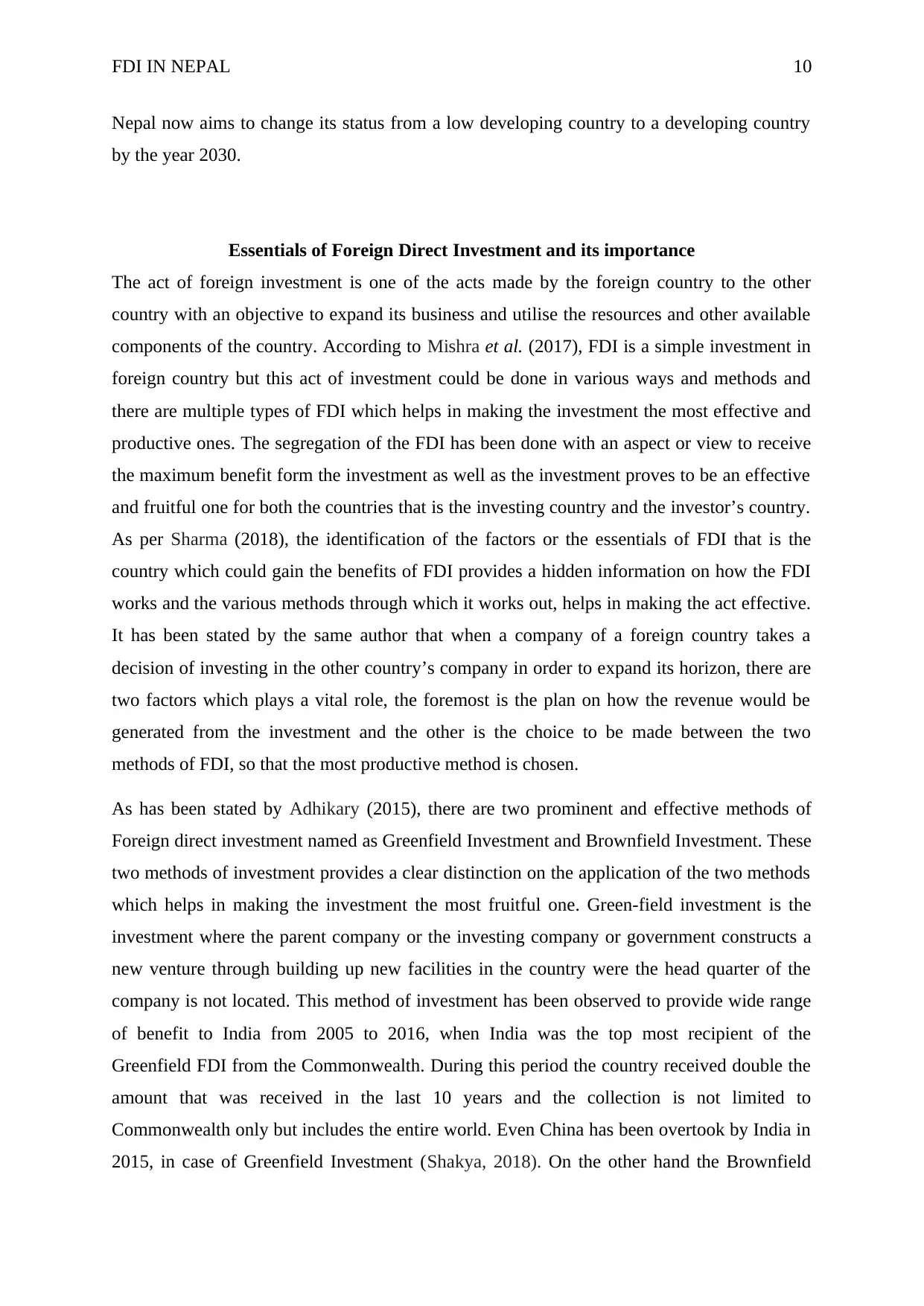
FDI IN NEPAL 10
Nepal now aims to change its status from a low developing country to a developing country
by the year 2030.
Essentials of Foreign Direct Investment and its importance
The act of foreign investment is one of the acts made by the foreign country to the other
country with an objective to expand its business and utilise the resources and other available
components of the country. According to Mishra et al. (2017), FDI is a simple investment in
foreign country but this act of investment could be done in various ways and methods and
there are multiple types of FDI which helps in making the investment the most effective and
productive ones. The segregation of the FDI has been done with an aspect or view to receive
the maximum benefit form the investment as well as the investment proves to be an effective
and fruitful one for both the countries that is the investing country and the investor’s country.
As per Sharma (2018), the identification of the factors or the essentials of FDI that is the
country which could gain the benefits of FDI provides a hidden information on how the FDI
works and the various methods through which it works out, helps in making the act effective.
It has been stated by the same author that when a company of a foreign country takes a
decision of investing in the other country’s company in order to expand its horizon, there are
two factors which plays a vital role, the foremost is the plan on how the revenue would be
generated from the investment and the other is the choice to be made between the two
methods of FDI, so that the most productive method is chosen.
As has been stated by Adhikary (2015), there are two prominent and effective methods of
Foreign direct investment named as Greenfield Investment and Brownfield Investment. These
two methods of investment provides a clear distinction on the application of the two methods
which helps in making the investment the most fruitful one. Green-field investment is the
investment where the parent company or the investing company or government constructs a
new venture through building up new facilities in the country were the head quarter of the
company is not located. This method of investment has been observed to provide wide range
of benefit to India from 2005 to 2016, when India was the top most recipient of the
Greenfield FDI from the Commonwealth. During this period the country received double the
amount that was received in the last 10 years and the collection is not limited to
Commonwealth only but includes the entire world. Even China has been overtook by India in
2015, in case of Greenfield Investment (Shakya, 2018). On the other hand the Brownfield
Nepal now aims to change its status from a low developing country to a developing country
by the year 2030.
Essentials of Foreign Direct Investment and its importance
The act of foreign investment is one of the acts made by the foreign country to the other
country with an objective to expand its business and utilise the resources and other available
components of the country. According to Mishra et al. (2017), FDI is a simple investment in
foreign country but this act of investment could be done in various ways and methods and
there are multiple types of FDI which helps in making the investment the most effective and
productive ones. The segregation of the FDI has been done with an aspect or view to receive
the maximum benefit form the investment as well as the investment proves to be an effective
and fruitful one for both the countries that is the investing country and the investor’s country.
As per Sharma (2018), the identification of the factors or the essentials of FDI that is the
country which could gain the benefits of FDI provides a hidden information on how the FDI
works and the various methods through which it works out, helps in making the act effective.
It has been stated by the same author that when a company of a foreign country takes a
decision of investing in the other country’s company in order to expand its horizon, there are
two factors which plays a vital role, the foremost is the plan on how the revenue would be
generated from the investment and the other is the choice to be made between the two
methods of FDI, so that the most productive method is chosen.
As has been stated by Adhikary (2015), there are two prominent and effective methods of
Foreign direct investment named as Greenfield Investment and Brownfield Investment. These
two methods of investment provides a clear distinction on the application of the two methods
which helps in making the investment the most fruitful one. Green-field investment is the
investment where the parent company or the investing company or government constructs a
new venture through building up new facilities in the country were the head quarter of the
company is not located. This method of investment has been observed to provide wide range
of benefit to India from 2005 to 2016, when India was the top most recipient of the
Greenfield FDI from the Commonwealth. During this period the country received double the
amount that was received in the last 10 years and the collection is not limited to
Commonwealth only but includes the entire world. Even China has been overtook by India in
2015, in case of Greenfield Investment (Shakya, 2018). On the other hand the Brownfield
Paraphrase This Document
Need a fresh take? Get an instant paraphrase of this document with our AI Paraphraser
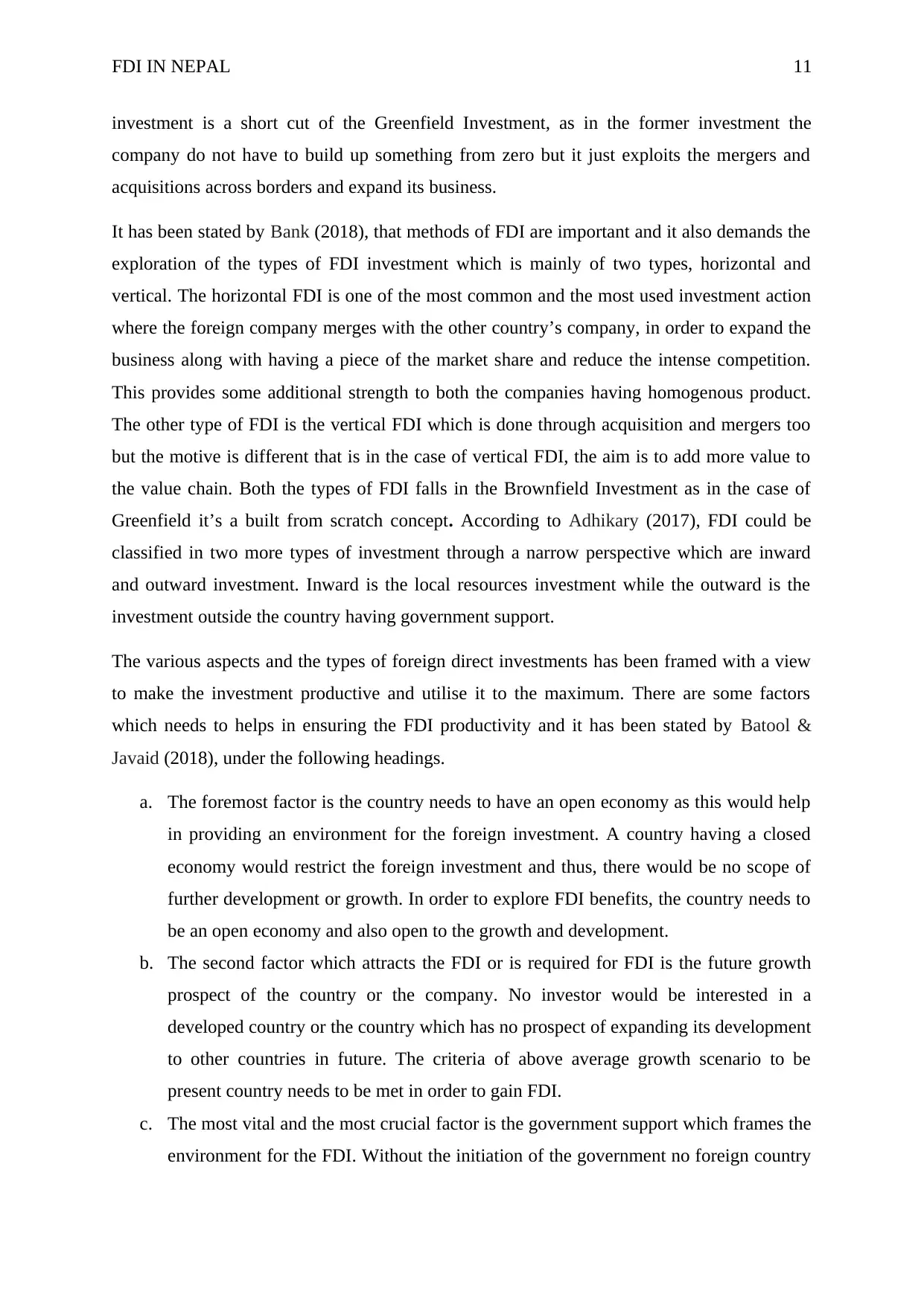
FDI IN NEPAL 11
investment is a short cut of the Greenfield Investment, as in the former investment the
company do not have to build up something from zero but it just exploits the mergers and
acquisitions across borders and expand its business.
It has been stated by Bank (2018), that methods of FDI are important and it also demands the
exploration of the types of FDI investment which is mainly of two types, horizontal and
vertical. The horizontal FDI is one of the most common and the most used investment action
where the foreign company merges with the other country’s company, in order to expand the
business along with having a piece of the market share and reduce the intense competition.
This provides some additional strength to both the companies having homogenous product.
The other type of FDI is the vertical FDI which is done through acquisition and mergers too
but the motive is different that is in the case of vertical FDI, the aim is to add more value to
the value chain. Both the types of FDI falls in the Brownfield Investment as in the case of
Greenfield it’s a built from scratch concept. According to Adhikary (2017), FDI could be
classified in two more types of investment through a narrow perspective which are inward
and outward investment. Inward is the local resources investment while the outward is the
investment outside the country having government support.
The various aspects and the types of foreign direct investments has been framed with a view
to make the investment productive and utilise it to the maximum. There are some factors
which needs to helps in ensuring the FDI productivity and it has been stated by Batool &
Javaid (2018), under the following headings.
a. The foremost factor is the country needs to have an open economy as this would help
in providing an environment for the foreign investment. A country having a closed
economy would restrict the foreign investment and thus, there would be no scope of
further development or growth. In order to explore FDI benefits, the country needs to
be an open economy and also open to the growth and development.
b. The second factor which attracts the FDI or is required for FDI is the future growth
prospect of the country or the company. No investor would be interested in a
developed country or the country which has no prospect of expanding its development
to other countries in future. The criteria of above average growth scenario to be
present country needs to be met in order to gain FDI.
c. The most vital and the most crucial factor is the government support which frames the
environment for the FDI. Without the initiation of the government no foreign country
investment is a short cut of the Greenfield Investment, as in the former investment the
company do not have to build up something from zero but it just exploits the mergers and
acquisitions across borders and expand its business.
It has been stated by Bank (2018), that methods of FDI are important and it also demands the
exploration of the types of FDI investment which is mainly of two types, horizontal and
vertical. The horizontal FDI is one of the most common and the most used investment action
where the foreign company merges with the other country’s company, in order to expand the
business along with having a piece of the market share and reduce the intense competition.
This provides some additional strength to both the companies having homogenous product.
The other type of FDI is the vertical FDI which is done through acquisition and mergers too
but the motive is different that is in the case of vertical FDI, the aim is to add more value to
the value chain. Both the types of FDI falls in the Brownfield Investment as in the case of
Greenfield it’s a built from scratch concept. According to Adhikary (2017), FDI could be
classified in two more types of investment through a narrow perspective which are inward
and outward investment. Inward is the local resources investment while the outward is the
investment outside the country having government support.
The various aspects and the types of foreign direct investments has been framed with a view
to make the investment productive and utilise it to the maximum. There are some factors
which needs to helps in ensuring the FDI productivity and it has been stated by Batool &
Javaid (2018), under the following headings.
a. The foremost factor is the country needs to have an open economy as this would help
in providing an environment for the foreign investment. A country having a closed
economy would restrict the foreign investment and thus, there would be no scope of
further development or growth. In order to explore FDI benefits, the country needs to
be an open economy and also open to the growth and development.
b. The second factor which attracts the FDI or is required for FDI is the future growth
prospect of the country or the company. No investor would be interested in a
developed country or the country which has no prospect of expanding its development
to other countries in future. The criteria of above average growth scenario to be
present country needs to be met in order to gain FDI.
c. The most vital and the most crucial factor is the government support which frames the
environment for the FDI. Without the initiation of the government no foreign country
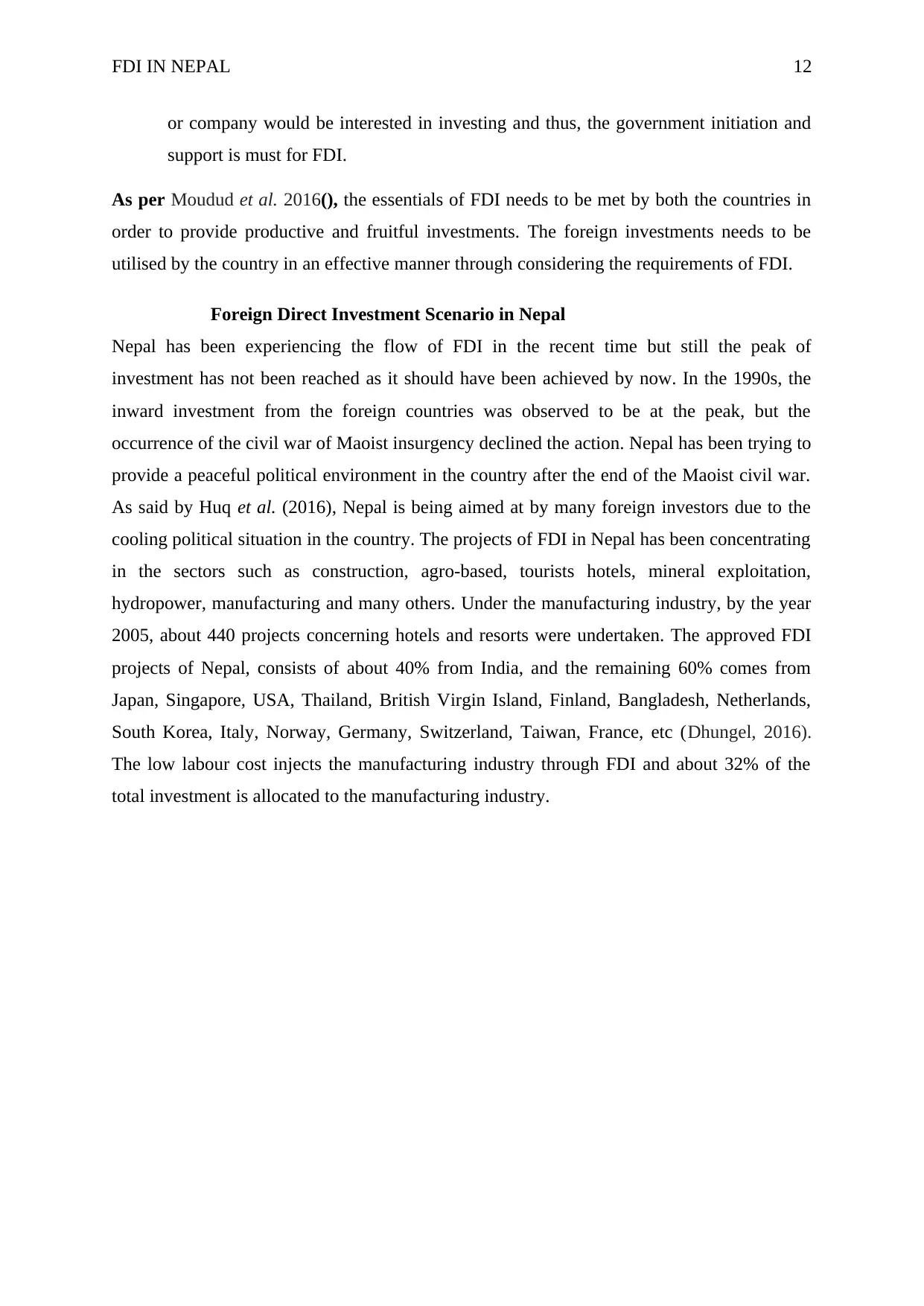
FDI IN NEPAL 12
or company would be interested in investing and thus, the government initiation and
support is must for FDI.
As per Moudud et al. 2016(), the essentials of FDI needs to be met by both the countries in
order to provide productive and fruitful investments. The foreign investments needs to be
utilised by the country in an effective manner through considering the requirements of FDI.
Foreign Direct Investment Scenario in Nepal
Nepal has been experiencing the flow of FDI in the recent time but still the peak of
investment has not been reached as it should have been achieved by now. In the 1990s, the
inward investment from the foreign countries was observed to be at the peak, but the
occurrence of the civil war of Maoist insurgency declined the action. Nepal has been trying to
provide a peaceful political environment in the country after the end of the Maoist civil war.
As said by Huq et al. (2016), Nepal is being aimed at by many foreign investors due to the
cooling political situation in the country. The projects of FDI in Nepal has been concentrating
in the sectors such as construction, agro-based, tourists hotels, mineral exploitation,
hydropower, manufacturing and many others. Under the manufacturing industry, by the year
2005, about 440 projects concerning hotels and resorts were undertaken. The approved FDI
projects of Nepal, consists of about 40% from India, and the remaining 60% comes from
Japan, Singapore, USA, Thailand, British Virgin Island, Finland, Bangladesh, Netherlands,
South Korea, Italy, Norway, Germany, Switzerland, Taiwan, France, etc (Dhungel, 2016).
The low labour cost injects the manufacturing industry through FDI and about 32% of the
total investment is allocated to the manufacturing industry.
or company would be interested in investing and thus, the government initiation and
support is must for FDI.
As per Moudud et al. 2016(), the essentials of FDI needs to be met by both the countries in
order to provide productive and fruitful investments. The foreign investments needs to be
utilised by the country in an effective manner through considering the requirements of FDI.
Foreign Direct Investment Scenario in Nepal
Nepal has been experiencing the flow of FDI in the recent time but still the peak of
investment has not been reached as it should have been achieved by now. In the 1990s, the
inward investment from the foreign countries was observed to be at the peak, but the
occurrence of the civil war of Maoist insurgency declined the action. Nepal has been trying to
provide a peaceful political environment in the country after the end of the Maoist civil war.
As said by Huq et al. (2016), Nepal is being aimed at by many foreign investors due to the
cooling political situation in the country. The projects of FDI in Nepal has been concentrating
in the sectors such as construction, agro-based, tourists hotels, mineral exploitation,
hydropower, manufacturing and many others. Under the manufacturing industry, by the year
2005, about 440 projects concerning hotels and resorts were undertaken. The approved FDI
projects of Nepal, consists of about 40% from India, and the remaining 60% comes from
Japan, Singapore, USA, Thailand, British Virgin Island, Finland, Bangladesh, Netherlands,
South Korea, Italy, Norway, Germany, Switzerland, Taiwan, France, etc (Dhungel, 2016).
The low labour cost injects the manufacturing industry through FDI and about 32% of the
total investment is allocated to the manufacturing industry.
⊘ This is a preview!⊘
Do you want full access?
Subscribe today to unlock all pages.

Trusted by 1+ million students worldwide
1 out of 29
Related Documents
Your All-in-One AI-Powered Toolkit for Academic Success.
+13062052269
info@desklib.com
Available 24*7 on WhatsApp / Email
![[object Object]](/_next/static/media/star-bottom.7253800d.svg)
Unlock your academic potential
Copyright © 2020–2025 A2Z Services. All Rights Reserved. Developed and managed by ZUCOL.





